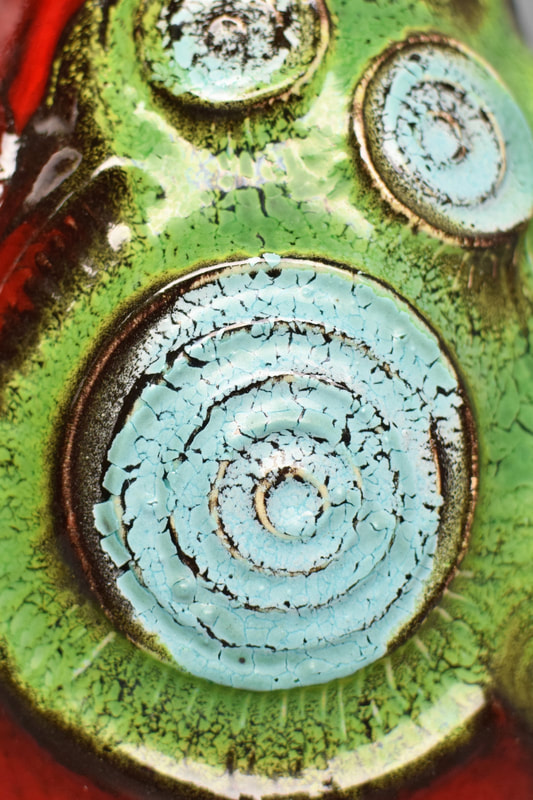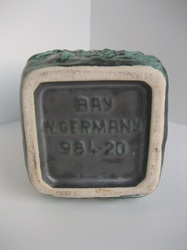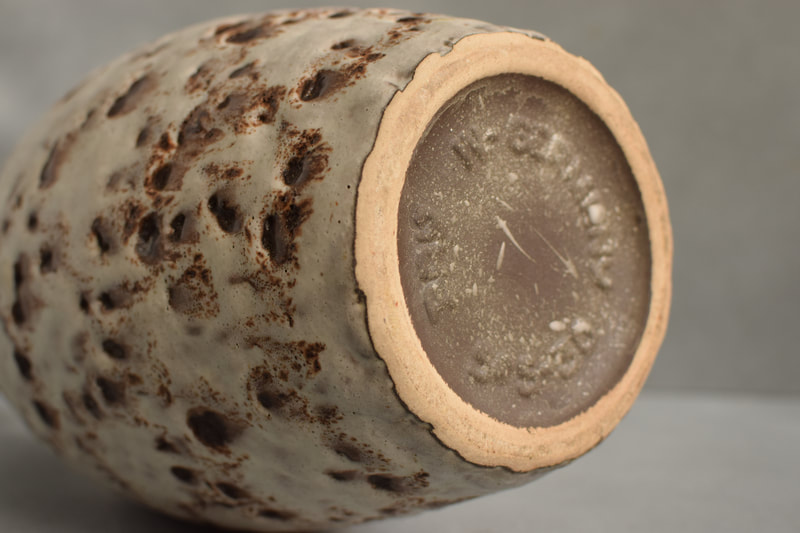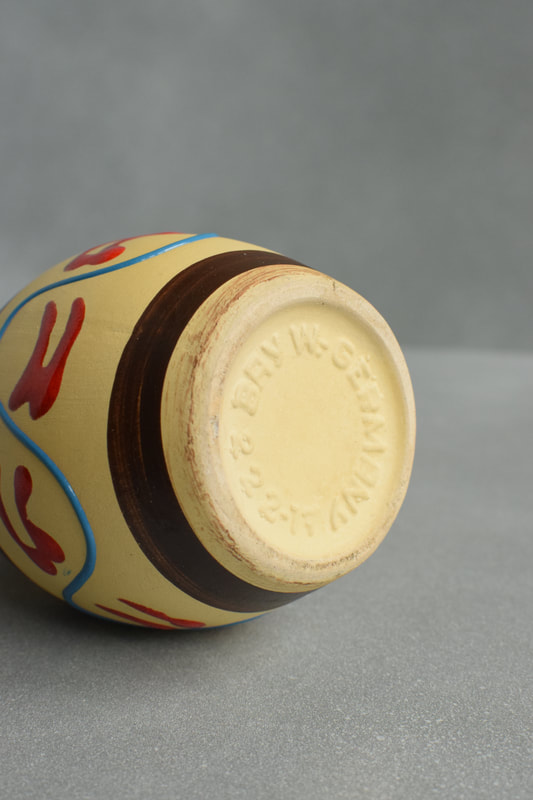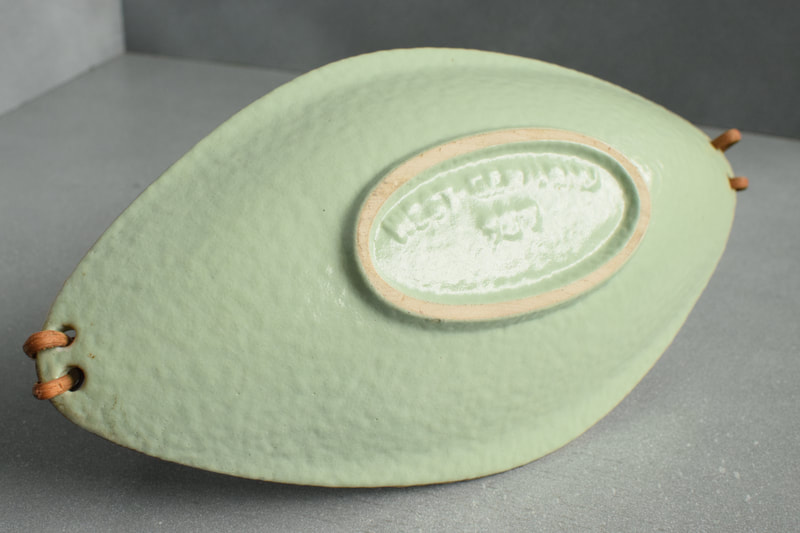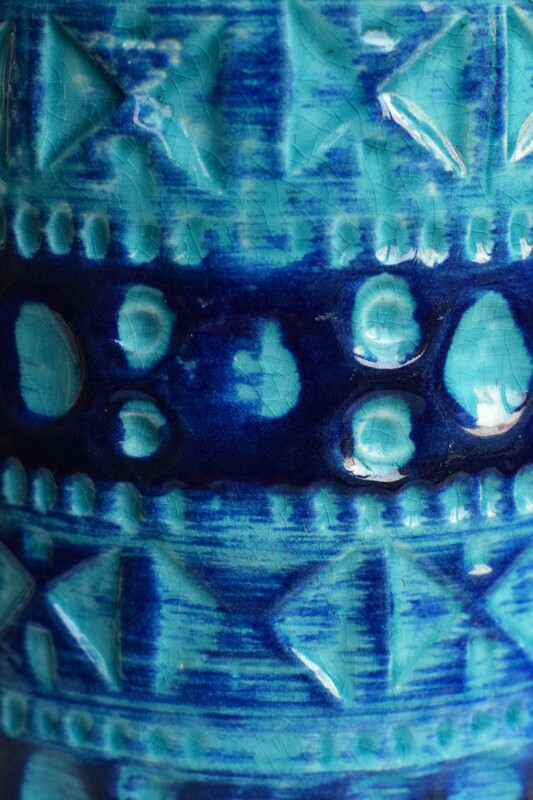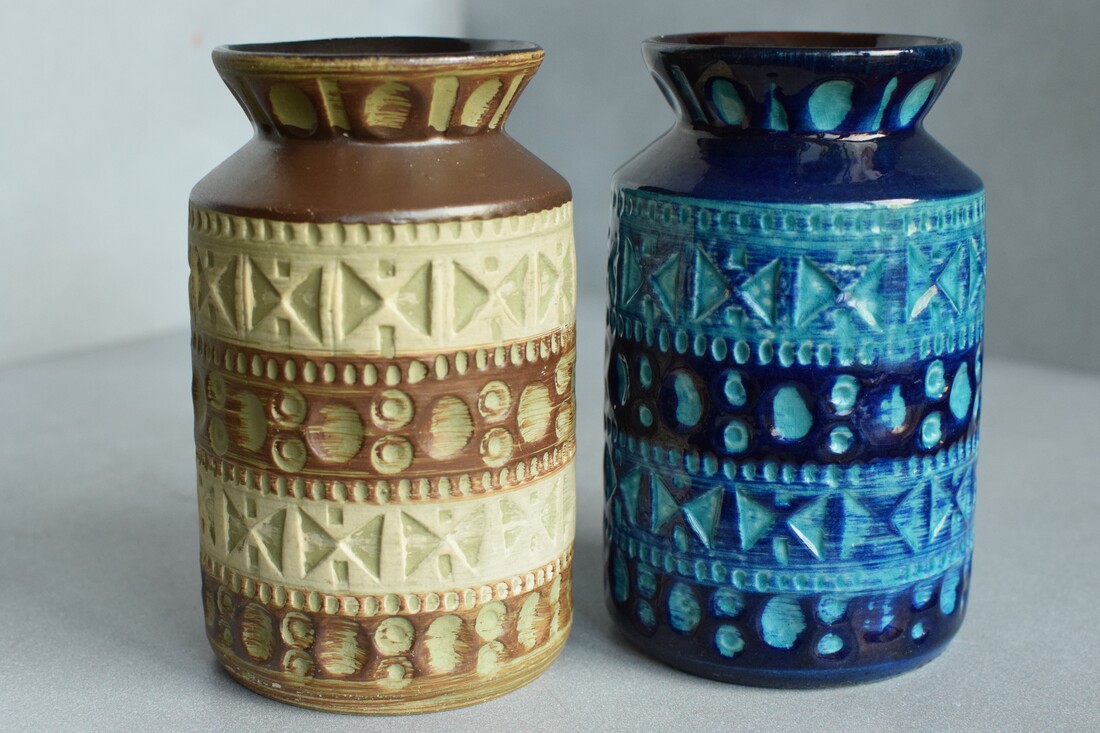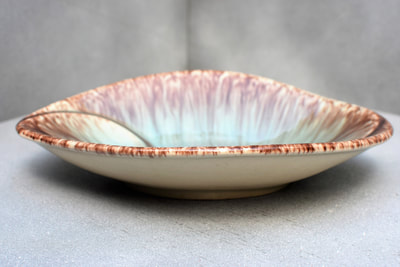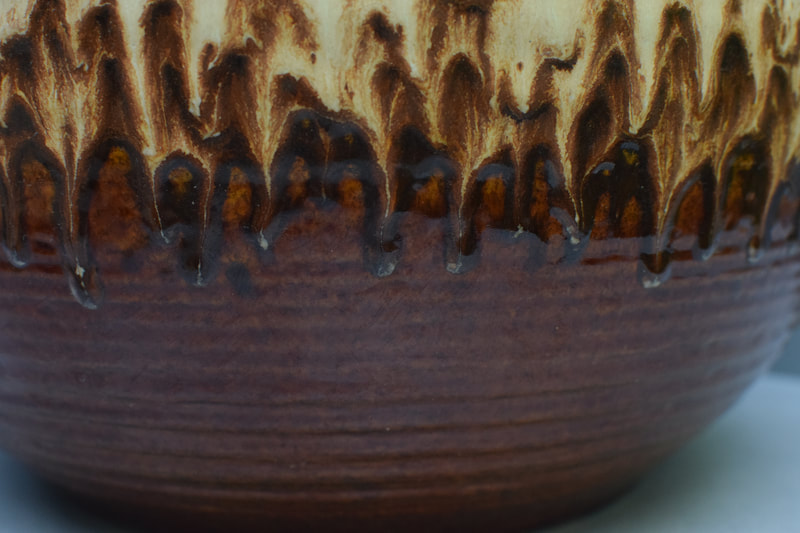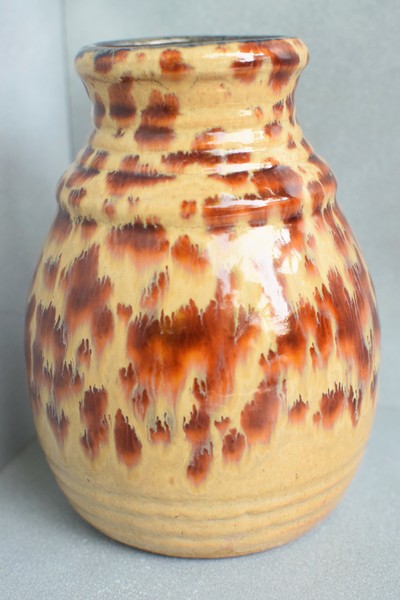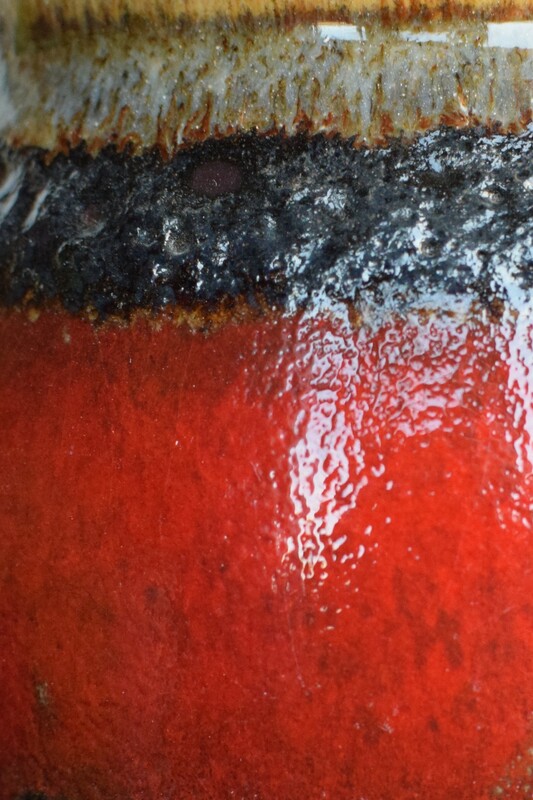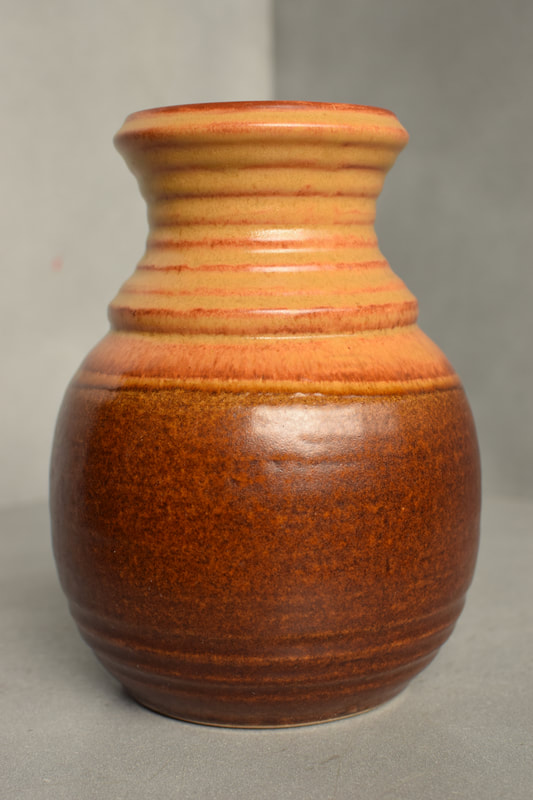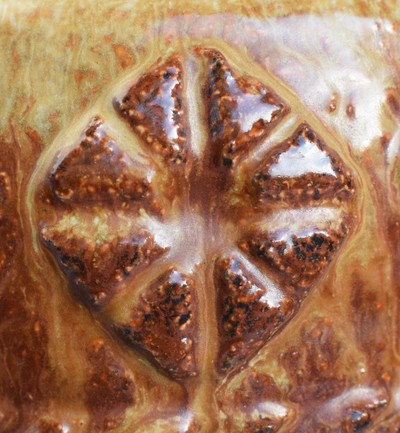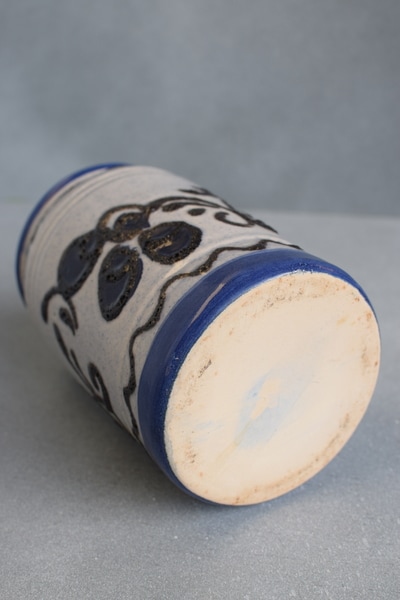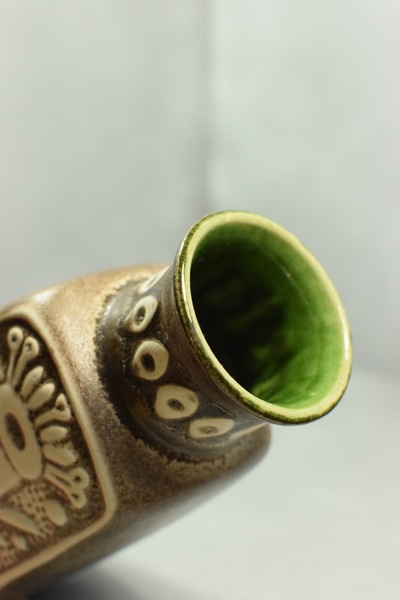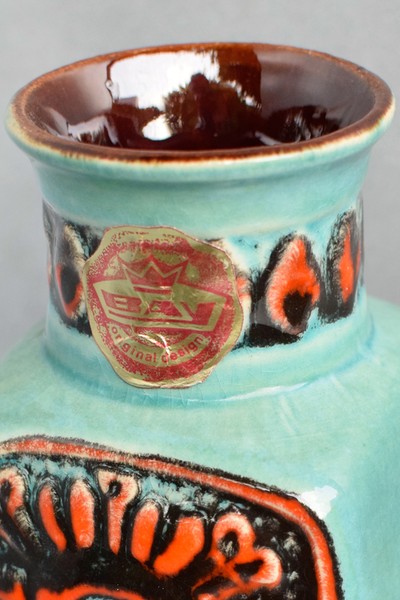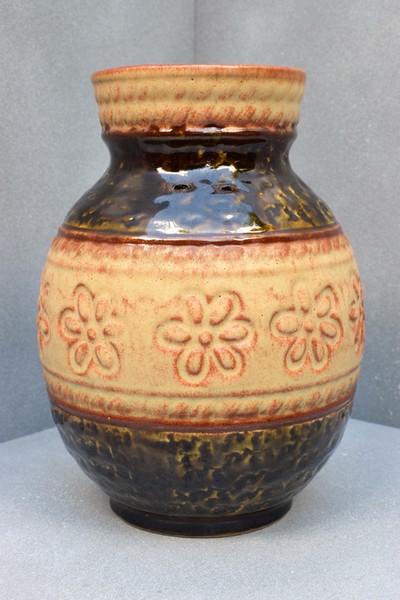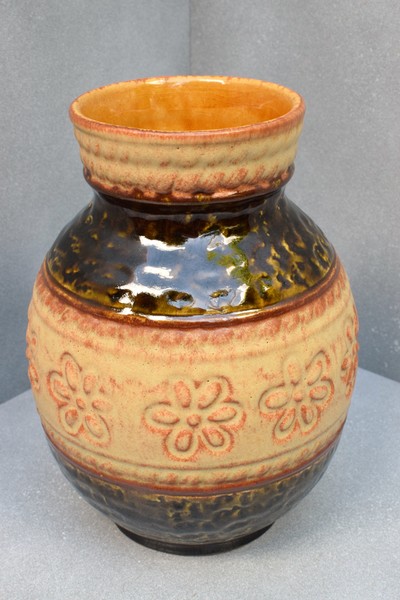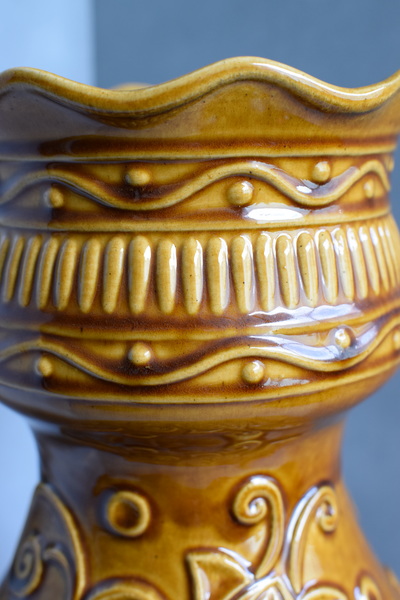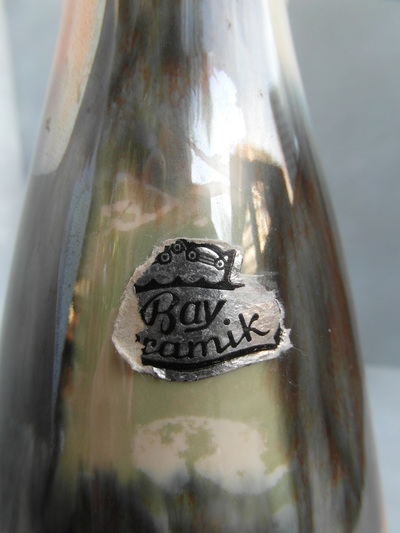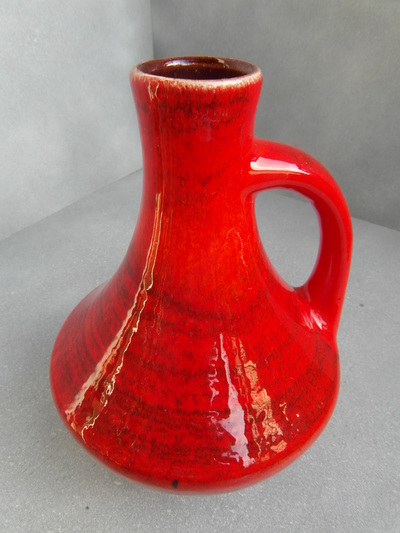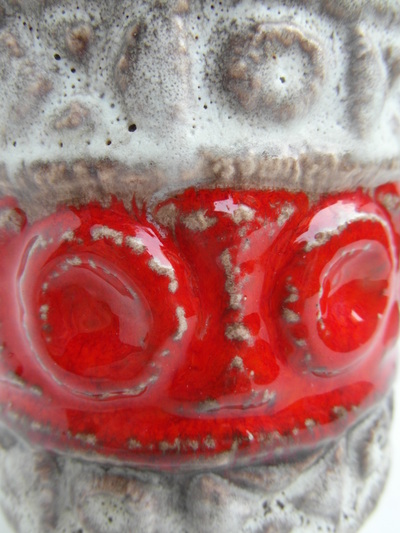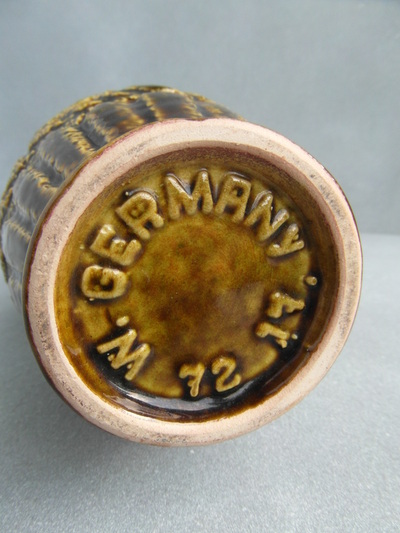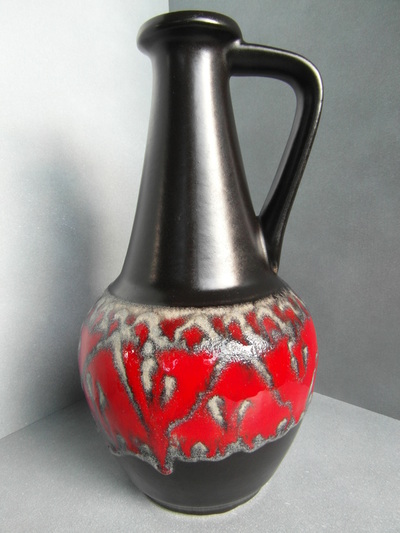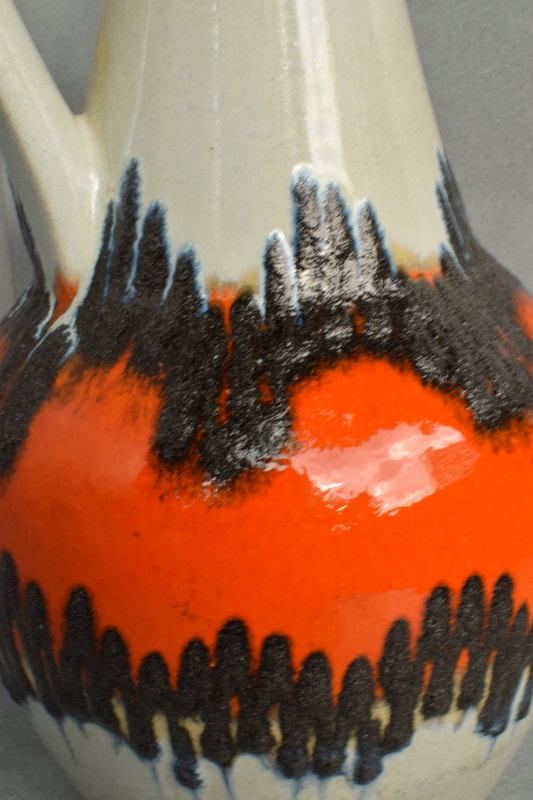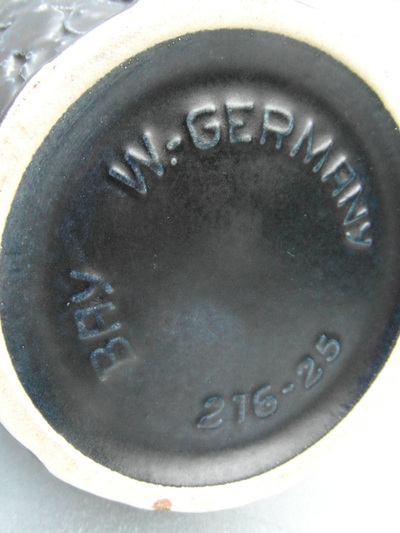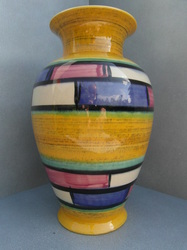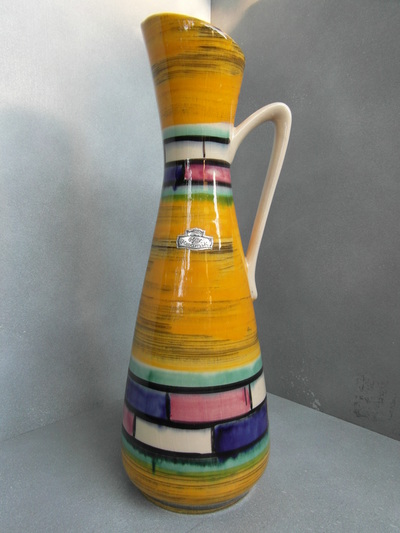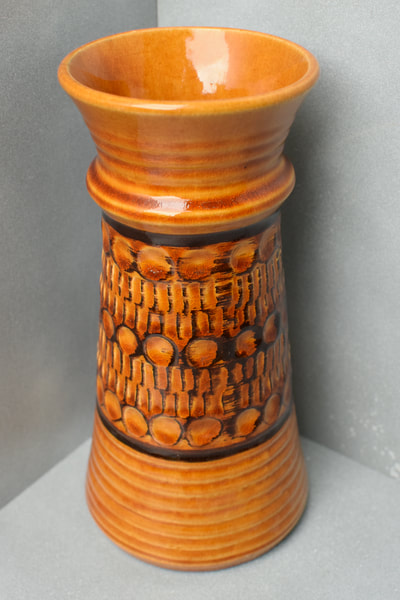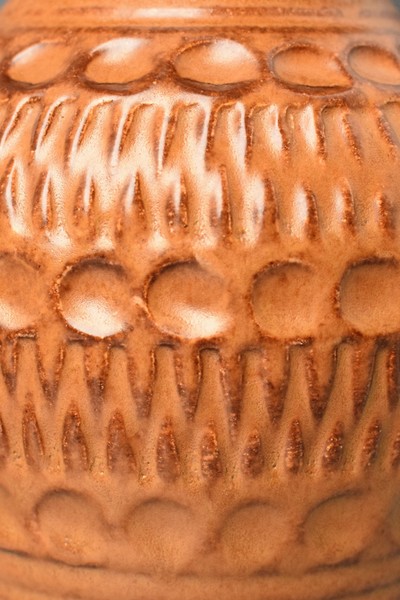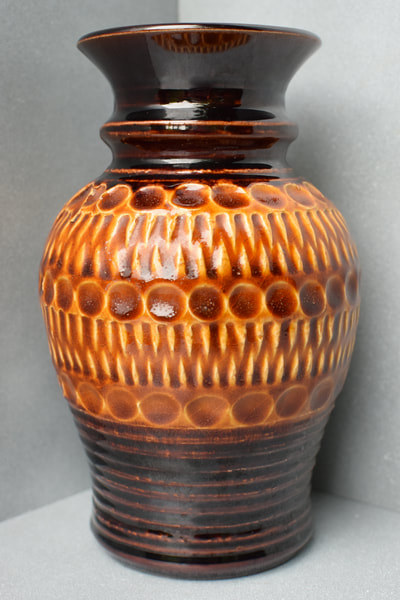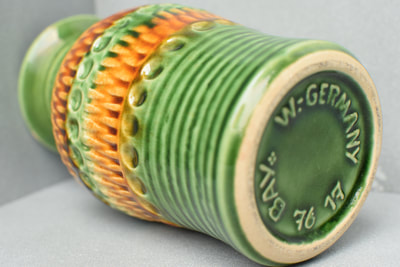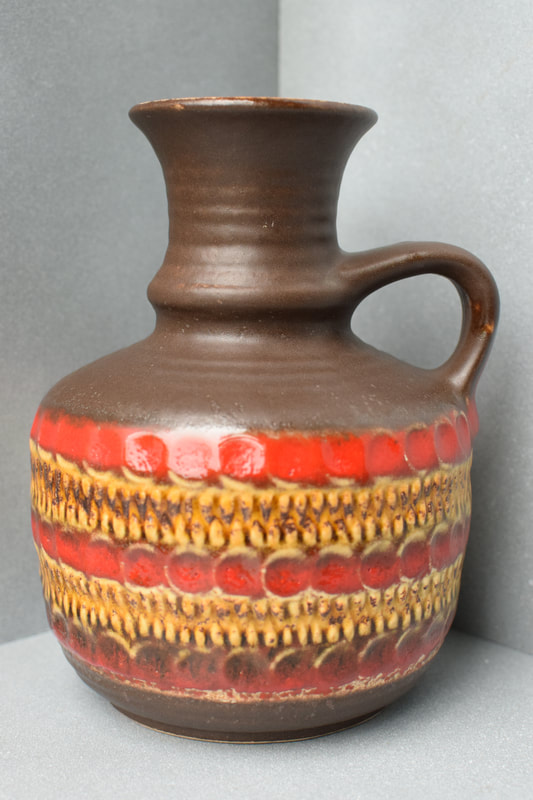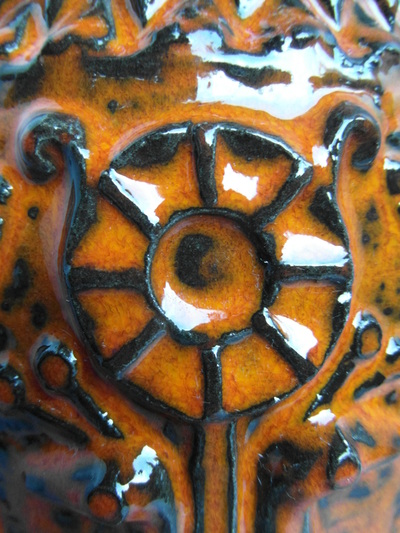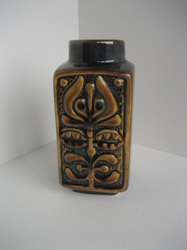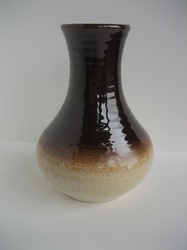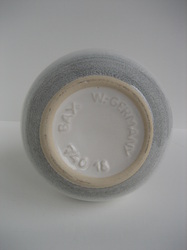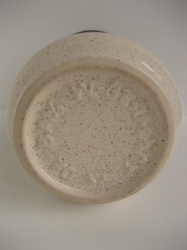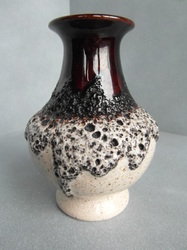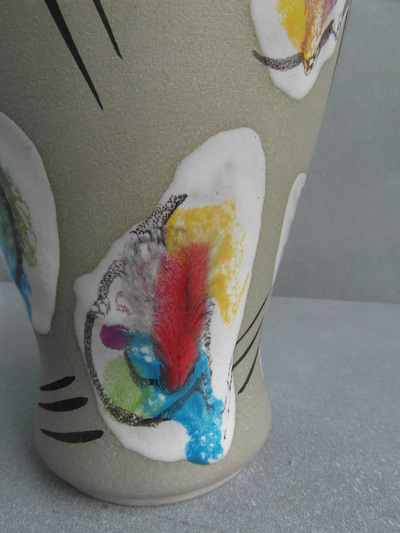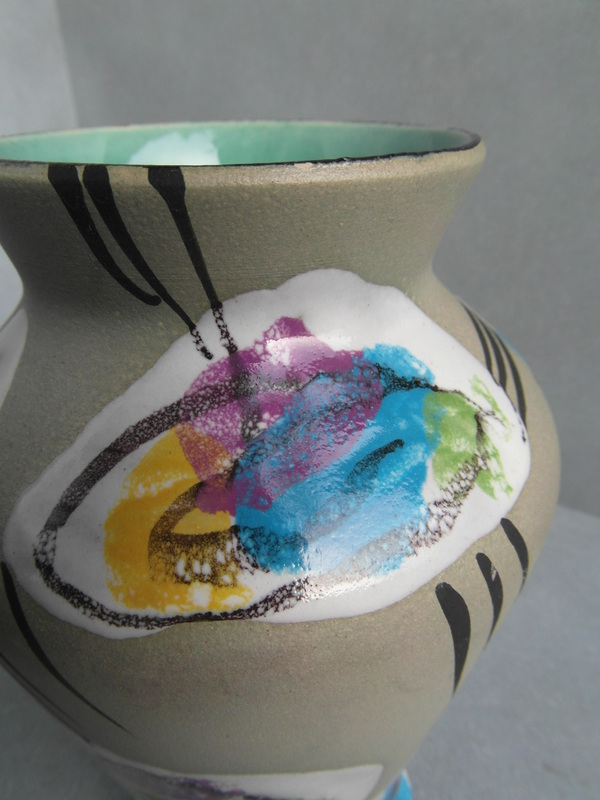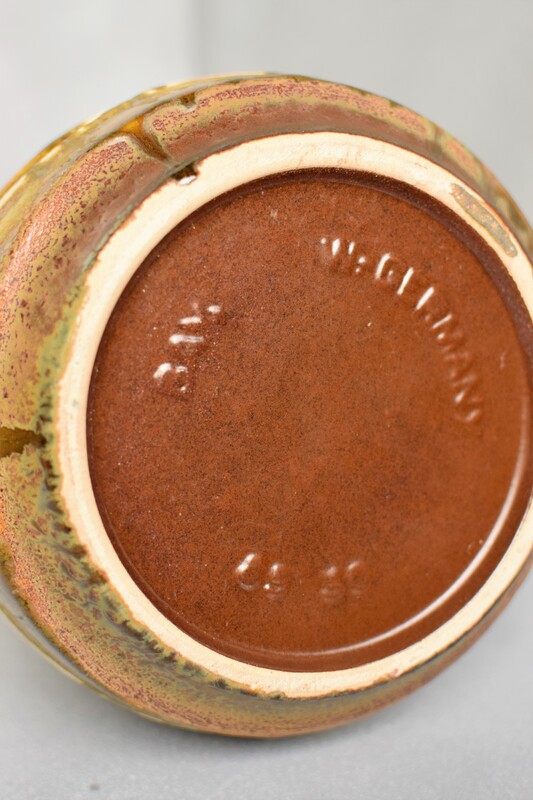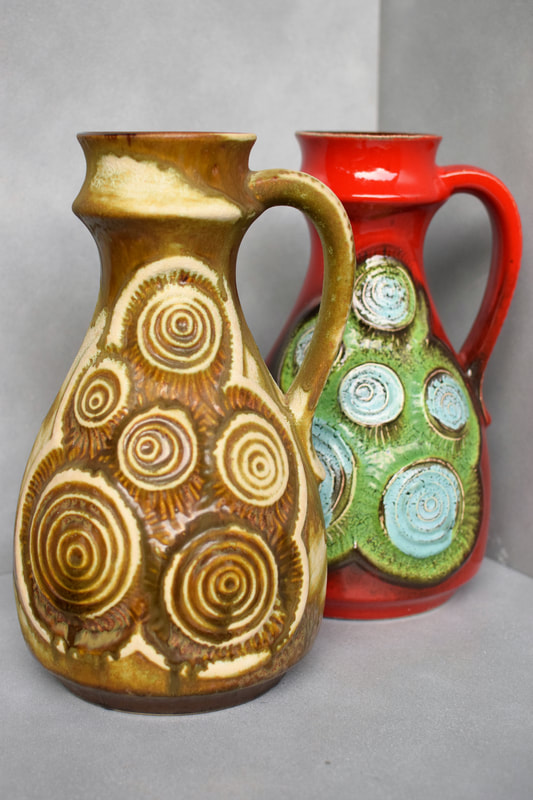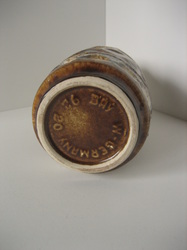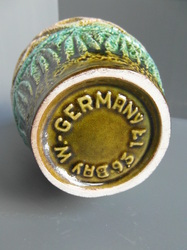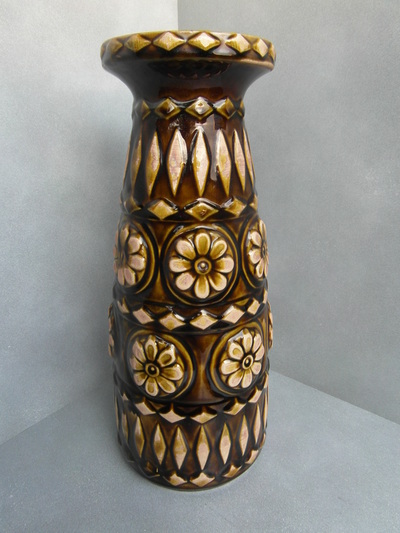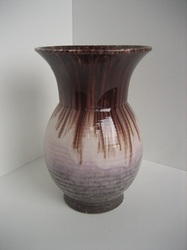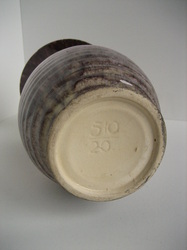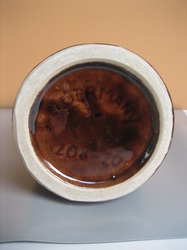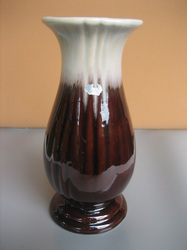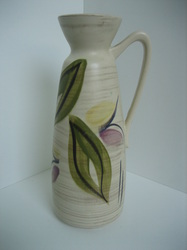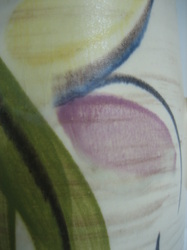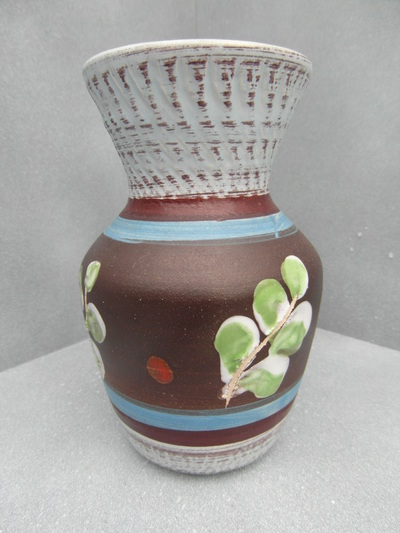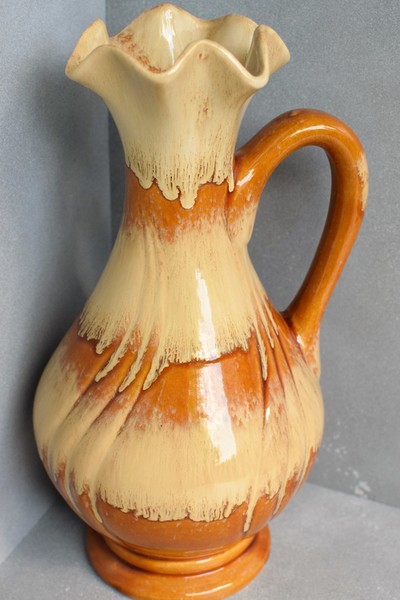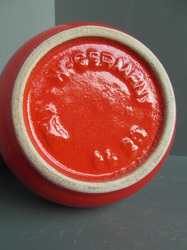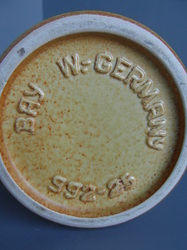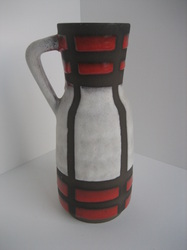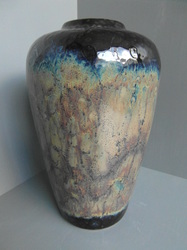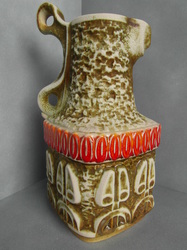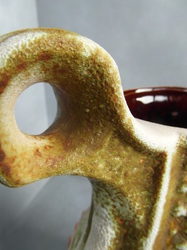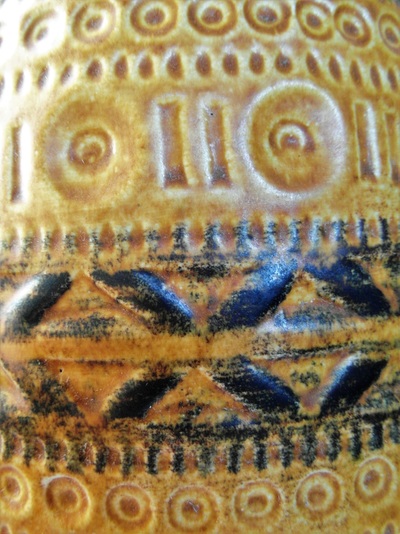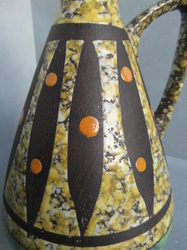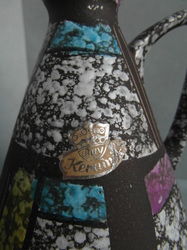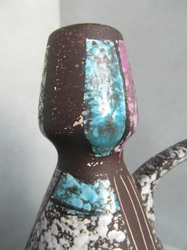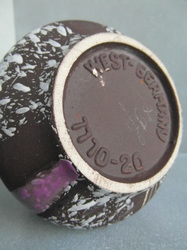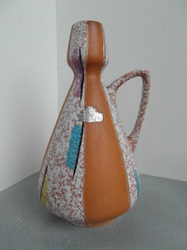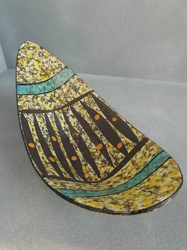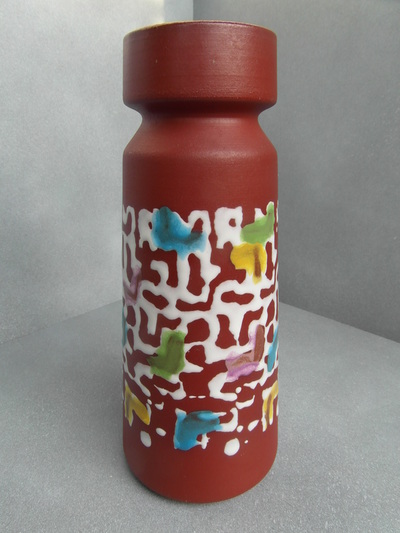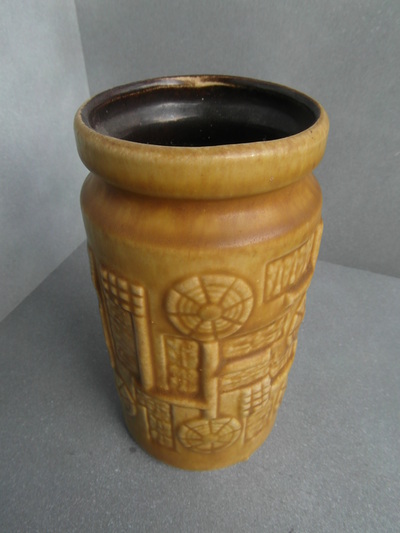Inhoud van deze pagina: Contents of this page:
|
-Inleiding/geschiedenis van Bay
-Uitleg over tekst aan de onderzijde van vazen -Labels van Bay -Uitleg over Alfred Bay -Uitleg over vormnummers -Foto's van vazen |
-Introduction/history of Bay
-Explanation about the text at the bottom of vases -Labels from Bay -Explanation about Alfred Bay -Explanation about formnumbers -Photographs of vases |
Bay Keramik.
Eduard Bay richtte Bay Keramik op in Ransbach-Baumbach in 1933. Vanaf de jaren vijftig tot begin jaren zeventig was Bay Keramik één van de meest succesvolle keramiekbedrijven. De decoraties zijn meestal voelbaar (in reliëf), vaak is er sprake van afbeeldingen met geometrische patronen. In 1967 was Bay een pionier in het maken van 'Römertöpfe'. Deze werden in dat jaar gepresenteerd op de Hannover Messe. Het bedrijf bleek in de fabricage daarvan uiterst succesvol en daarom besloot de directie in 1971 om de poreuze, aardewerken schalen met deksel voortaan op de markt te brengen onder de merknaam RÖMERTOPF®.
Bay Keramik hield in 1997 op te bestaan. De firma Gerz uit Sessenbach nam het merk RÖMERTOPF® over en veranderde de bedrijfsnaam in RÖMERTOPF® Keramik GmbH. De vestigingsplaats van RÖMERTOPF® Keramik GmbH is nog altijd Ransbach-Baumbach (Weiherstraße 1) en van daaruit vinden schalen voor onder andere vlees, vis, aardappelen, knoflook en appels hun weg naar miljoenen huishoudens.
Site: http://www.roemertopf.de/
Bay gebruikte voor de vervaardiging van de vazen altijd witte klei. Ontwerpers: o.a. Bodo Mans ('Ravenna' en 'Paris' serie), Lu Klopfer en A. Seide.
Bay Keramik hield in 1997 op te bestaan. De firma Gerz uit Sessenbach nam het merk RÖMERTOPF® over en veranderde de bedrijfsnaam in RÖMERTOPF® Keramik GmbH. De vestigingsplaats van RÖMERTOPF® Keramik GmbH is nog altijd Ransbach-Baumbach (Weiherstraße 1) en van daaruit vinden schalen voor onder andere vlees, vis, aardappelen, knoflook en appels hun weg naar miljoenen huishoudens.
Site: http://www.roemertopf.de/
Bay gebruikte voor de vervaardiging van de vazen altijd witte klei. Ontwerpers: o.a. Bodo Mans ('Ravenna' en 'Paris' serie), Lu Klopfer en A. Seide.
Bay Keramik.
Eduard Bay founded Bay Keramik in Ransbach-Baumbach in 1933. From the fifties to the beginning of the sixties Bay Keramik was one of the most successful ceramic businesses. Decorations can most often be felt (in relief) , quite often we see images with geometrical patterns. In 1967 Bay pioneered in making the so-called ‘Römertöpfe’. In that year they were presented at the ‘Hannover Messe’(a famous annual fair). It turned out that this business had been extremely successful in the manufacture of this product. That is why the management decided to market the porous, earthenware bowls with lids under the registerd brand name RÖMERTOPF.
Bay Keramik ceased to exist in 1997. The Gerz concern from Sessenbach incorprated the brand RÖMERTOPF and changed the name of the concern into RÖMERTOPF Keramik GmbH.To this day it is still located in Ransbach-Baumbach ( Weiherstrasse 1 to be precise). From this branch bowls for among other things meat, fish, potatoes, garlic and apples find their way to millions of households.
Website http://www.roemertopf.de/
Bay availed themselves of white clay for the manufacture of the vases.
Designers: among others Bodo Mans (‘Ravenna’ and ‘Paris’series), Lu Klopfer and A. Seide.
Bay Keramik ceased to exist in 1997. The Gerz concern from Sessenbach incorprated the brand RÖMERTOPF and changed the name of the concern into RÖMERTOPF Keramik GmbH.To this day it is still located in Ransbach-Baumbach ( Weiherstrasse 1 to be precise). From this branch bowls for among other things meat, fish, potatoes, garlic and apples find their way to millions of households.
Website http://www.roemertopf.de/
Bay availed themselves of white clay for the manufacture of the vases.
Designers: among others Bodo Mans (‘Ravenna’ and ‘Paris’series), Lu Klopfer and A. Seide.
De vazen zijn aan de onderkant meestal gemerkt met 'BAY'. Op de bodem staat meestal een getal van twee of drie cijfers (modelnummer) gevolgd door een spatie of streepje en een getal dat de
hoogte in centimeters aangeeft. Bay duidt het land van herkomst aan met 'W.-GERMANY'.
Let op de typische vorm van de 'y '.
The vases are usually marked ’BAY’at the bottom. Most of the time there is a number of two or three digits (model number) on the bottom, followed by a space or a hyphen and a figure that indicates the height in centimetres.By adding ’W.-Germany’ Bay shows the country of origin.
Mind the typical shape of ‘y ‘.
In de jaren vijftig en zestig gebruikte Bay een label van folie in goud- of zilverkleur met een 'kroontje' en de opdruk 'Bay Keramik'. In de jaren zeventig en tachtig gebruikte Bay een rechthoekige sticker van papier met daarop de tekst 'BAY KERAMIK'.
In the fifties and sixties Bay used a label of gold or silver coloured foil with a ‘coronet ‘ and the print ‘Bay Keramik’. In the seventies and eighties Bay used a rectangular paper sticker with the text ‘BAY KERAMIK’.
In the fifties and sixties Bay used a label of gold or silver coloured foil with a ‘coronet ‘ and the print ‘Bay Keramik’. In the seventies and eighties Bay used a rectangular paper sticker with the text ‘BAY KERAMIK’.
Er zijn in de jaren-50 vazen geproduceerd met een sticker van A. Bay. Dit was Alfred Bay, een broer van Eduard Bay. Hun vader heette Anton Bay en deze had een fabriek waar buizen van aardewerk geproduceerd werden. Dit bedrijf werd waarschijnlijk al in de jaren-30 gesloten. Het bedrijf van Alfred Bay was een kleine keramiekfabriek die voor een klein aantal jaar, in de jaren-50, actief is geweest.
Ik heb helaas geen vazen van Alfred Bay.
In the 50s vases have been produced with a sticker of A. Bay. This was Alfred Bay, Eduard Bay’s brother. Their father was called Anton Bay who had a factory where earthenware tubes were manufactured. This business probably ceased to exist in the 30s. Alfred Bay’s business was a small ceramics factory that was active in the 50s for a limited number of years.
I am sad to say that I do not have any vases by Alfred Bay.
Vaas met vorm nr. 71 17 / vase with form nr. 71 17.
Vaas met vorm nr. 947-17 / vase with form nr. 947-17.
Vaas met vorm nr. 505-30 / vase with form nr. 505-30.
Vaas met vorm nr. 215-17 / vase with form nr. 215-17.
Vaas met vorm nr. 86-14 / Vase with form nr. 86-14.
Vaas met vorm nr. 572-20 uit 1958. Het decor heet 'Peru'.
Vase with form nr. 572-20, made in 1958, decorname is: 'Peru'.
Vaas met vorm nr. 632-20 / vase with form nr. 632-20
Vaas met vorm nr. 222-17 / Vase with form nr. 222-17.
Twee vazen met vorm nr. 581-14. Vorm nr. 581 is gedocumenteerd van 1958-1967.
Links decor: 'Texas', uit 1960.
Two vases with form nr. 581-14. Form nr. 581 is documented from 1958-1967.
On the left decor: 'Texas', produced in 1960.
Bonbonschaaltje met vorm nr. 927 / Chocolate dish with form nr. 927.
Twee vazen met vorm nr. 503-14 / Two vases with form nr. 503/14.
Vaas met vorm nr. 82-12. Vase with form nr. 82-12.
Vaas met vorm nr. 650-21 / Vase with form nr. 650-21.
Afwerking heet 'Spritzdekor'. Glazuur wordt met een fijn spuitpistool opgebracht en m.b.v. sjablonen ontstaan figuren.
Finishing is called 'Spritzdekor'. The glaze is applicated by means of spraying and using templates to create figures.
Finishing is called 'Spritzdekor'. The glaze is applicated by means of spraying and using templates to create figures.
Vaas met vorm nr. 50-17, ca. 1950. Vase with form nr. 50-17, ca. 1950.
Deze vaas met vorm nr. 50 was onderdeel van de B-serie, bijv. B 50. Bij latere vazen werd de B weggelaten. Het label werd gebruikt vanaf 1947, maar deze vaas is gemaakt halverwege de 50-er jaren omdat dit decor 'Köln' werd geintroduceerd in 1954/1955.
The vase with shape nr. 50 was part of the B-series, e.g. vase B 50, later vases without B at the base. The label was introduced in 1947, but this copy is from mid 1950-ies, as the decor 'Köln' was introduced in 1954/1955.
Met dank aan / Special thanks to: Fritz Lothar Wulf
https://lavaguys-ceramic.blogspot.com/2018/12/eduard-bay-bay-keramik.html
en aan / and to: Volker Hornbostel.
The vase with shape nr. 50 was part of the B-series, e.g. vase B 50, later vases without B at the base. The label was introduced in 1947, but this copy is from mid 1950-ies, as the decor 'Köln' was introduced in 1954/1955.
Met dank aan / Special thanks to: Fritz Lothar Wulf
https://lavaguys-ceramic.blogspot.com/2018/12/eduard-bay-bay-keramik.html
en aan / and to: Volker Hornbostel.
Schaal met vorm nr. 912 / dish with formnr. 912.
Vaas met vorm nr. 631 45 / Vase with form nr. 631 45.
Vaas met vorm nr. 631/40 / Vase with form nr. 631/40.
Vaas met vorm nr. 73 20.
Vazen met vorm nr. 630 14.
Vaas met vorm nr. 630 17 / Vase with form nr. 630 17.
Vaas met vorm nr. 631 14.
Vaas met vorm nr. 72 25.
Vaas met onbekend vorm nr. / Vase with unknown form nr.
Met papieren label dat werd gebruikt voor keukengerei / With paper label that was used for kitchenware.
Vaas met vorm nr. 251-35.
Vazen met vorm nr. 96 20.

Foto uit een Bay catalogus van 1971.
De decornaam gaat over de kleur en niet het relief.
The decors zijn genoemd naar Scandinavische steden, het decor op de afbeelding heet Upsala.
Picture from an old Bay catalogue from 1971.
The decornames concern the colour not the relief.
Decors named after scandinavian towns, here Upsala in Sweden.
Special thanks to Volker Hornbostel.
Vaas met vorm nr. 96 25.
Vaas met vorm nr. 96 14.
Vaas met vorm nr. 660 17.
Vaas met vorm nr. 661-40.
Vaas met vorm nr. 62 45.
Vaas met vorm nr. 243-25. Decor: 'Korsika' uit 1959.

Bladzijde uit een catalogus van Bay uit 1959. Getoond wordt het decor 'Korsika'.
Page from a 1959 catalog of Bay. The decor 'Korsika' is shown.
Vaas met vorm nr. 67 17.
Vaas met vorm nr. 225-25. Ontwerp: Heinz Siery.
Vaas met vorm nr. 92-14.
Vaas met vorm nr. 72 17.
Vazen met vorm nr. 67 30.
Vaas met vorm nr. 216-25.
Vaas met vorm nr. 660-20 en vorm nr. 522-25.
Vazen met vorm nr. 403-25(boven), vorm nr. 246-35(midden) en vorm nr. 298-17(onder).
Vases with form nr. 403-25(above), form nr. 246-35(middle) and form nr. 298-17(below).
Decor: 'Kuwait' / Decor: 'Kuwait'.
Vaas met vorm nr. 298-17.
|
Serie vazen met vorm nr. 76.
Vaas met vorm nr. 77 17.
Vaas met vorm nr. 961-30.
Serie vazen:
Serie vazen met vorm nr. 740.
Serie vazen.
Vaasje met vorm nr. 242-10, decor: 'Kongo'. Ontwerp: Bodo Mans.
Enkele details:
Vaas met vorm nr. 605-17, decor: 'Delhi'. Ontwerp: Bodo Mans.
Twee vazen met vorm nr. 85 30.
Serie vazen.
Vaas met vorm nr. 585-28.
Vazen met vorm nr. 76 35.
Vaas met vorm nr. 76 20.
Vaas met vorm nr. 510/20, uit 1950.
Herkenbaar door de grootte, het glazuur, de ongeglazuurde onderkant en het ontbreken van een fabrieksmerk. Dit vormnummer werd uitgebracht vanaf 1938 en daarna in 1940, 1941 en 1950. Het werd in verschillende groottes gemaakt. Het model van 1950 werd alleen uitgevoerd in de hoogte van 20cm.
To be recognized by its size, enamel, its unglazed bottom and the missing of a brand name. This shape number was marketed from 1938 and since then in 1940m 1941 and in 1950. It was manufactured in different sizes. The 1950 model was only executed in a 20-centimetre-height.
To be recognized by its size, enamel, its unglazed bottom and the missing of a brand name. This shape number was marketed from 1938 and since then in 1940m 1941 and in 1950. It was manufactured in different sizes. The 1950 model was only executed in a 20-centimetre-height.
